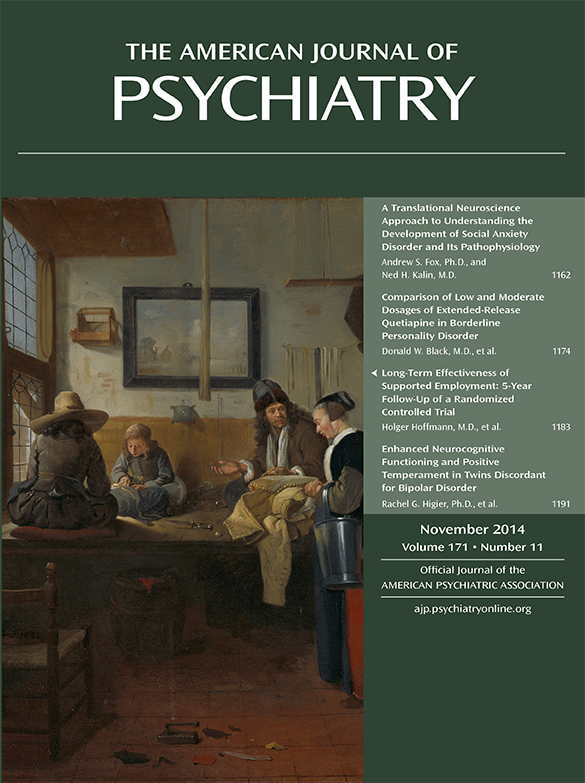No pharmacologic treatment has received regulatory approval for borderline personality disorder, in the United States or elsewhere. According to a 2010 Cochrane systematic review, 27 randomized clinical trials of pharmacologic agents had been conducted in borderline personality disorder up to 2008 (
1). In the past 5 years, most such trials have focused on mood stabilizers and second-generation antipsychotics. Among the second-generation antipsychotics, there has been one study with positive findings for aripiprazole (
2), one study with negative findings for ziprasidone (
3), and three studies with mixed results for olanzapine (
4–
6). Studies have suggested efficacy for several anticonvulsants, including valproate, lamotrigine, and topiramate (
1). There have also been a number of negative studies for antidepressants, including fluoxetine, fluvoxamine, mianserin, and phenelzine (
1).
An article in this issue by Black et al. on the use of quetiapine in borderline personality disorder (
7) represents an addition to the list of studies assessing the use of pharmacotherapy in the treatment of this disorder. Although other studies have been conducted using this agent for this indication (
1), it appears that this is the first to target improvement in the general psychopathology of borderline personality disorder.
The results of the Black et al. study are important for a disorder that has a prevalence close to 6% in the United States (
8). The authors, known experts in the field, conducted a randomized clinical trial with 94 patients with DSM-IV borderline personality disorder who were randomly assigned to receive either placebo (N=29) or extended-release quetiapine at either 150 mg/day (the low-dosage group; N=33) or 300 mg/day (the moderate-dosage group; N=33). The primary outcome measure was the change in total score on the clinician-rated Zanarini Rating Scale for Borderline Personality Disorder (
9), which is a strength because the scale includes items that correspond to the DSM criteria for the disorder.
The efficacy results are encouraging. On the primary outcome measure, the difference in improvement between the low-dosage quetiapine group and the placebo group was statistically significant (effect size=−0.79, p=0.031). However, the difference between the moderate-dosage quetiapine group and the placebo group was not (effect size=−0.41, p=0.265). Furthermore, the percentage of participants classified as responders for at least one postbaseline visit was 82% for the low-dosage group and 67% for the moderate-dosage group. The number needed to treat was 2.9 for the low-dosage group and 3.9 for the moderate-dosage group.
The sample size of 33 in each dosage group, with the goal of detecting an effect size for efficacy greater than 0.68, is reasonable, but as in most clinical trials it was not estimated for safety parameters. Therefore, a lack of significant differences between groups on some safety parameters should be interpreted with caution.
Patients in the moderate-dosage group had a higher (though nonsignificant) risk of having an adverse event thought to be related to study medication (hazard ratio=1.73, p=0.074). Sedation, change in appetite, dry mouth, and dizziness were also more likely for the moderate-dosage group. In addition, time to discontinuation was shorter among those in the moderate-dosage group than those in the low-dosage group, but not significantly different from placebo for either group. Risk of discontinuation increased with the severity of any adverse event (hazard ratio=1.74, p=0.018), and sedation was predictive of discontinuation (hazard ratio=1.77, p=0.025).
In general, changes in weight and lipids were not significantly different among groups. This is most likely due to the short duration of the study. However, among those who completed the study, the mean weight gained was 1 pound for the placebo group, 1 pound for the low-dosage group, and 3 pounds for the moderate-dosage group.
Patients in the placebo group had the highest completion rate (79%), most likely because this group had fewer adverse events. The fact that the low-dosage group had a higher completion rate (67%, compared with 58% for the moderate-dosage group) is itself an important effectiveness outcome measure. It may also have contributed to the efficacy results; in fact, sedation was a predictor of discontinuation.
As with any efficacy clinical trial, an important limitation resulting from the inclusion and exclusion criteria is the generalizability of the findings. Based on prevalent data on clinical populations, exclusion of patients with addiction disorders, posttraumatic stress disorder, or mood disorders that carry a high risk of suicidal behavior could meaningfully limit generalizability (
10).
A major treatment challenge in borderline personality disorder, as for any other long-term condition, is maintenance treatment. The Black et al. study only demonstrates what appears to be a clinically meaningful improvement, but only for a brief period. Whether efficacy is maintained for patients who benefit from quetiapine after 8 weeks remains to be determined. Even if maintenance of response is sustained, however, the long-term risks of quetiapine and other second-generation antipsychotics, specifically metabolic dysregulation, would certainly be a deterrent for its long-term use in many patients suffering from this condition. In addition, some symptoms do not seem to improve with existing pharmacotherapies, including quetiapine, such as chronic feelings of emptiness, which appear to respond better with evidence-based psychotherapies (
11).
In summary, the Black et al. study is a well-designed clinical trial that provides evidence that low-dosage quetiapine (150 mg) is effective in the short-term treatment of some of the core symptoms of borderline personality disorder. The estimated effect size (−0.79) and number needed to treat for response (2.9) suggest a moderate to large effect on the primary outcome. A number of questions remain, notably about whether the response will be maintained over longer periods and about long-term safety, especially in regard to metabolic syndrome. Effectiveness studies need to be conducted to determine the risks and benefits of low-dosage quetiapine in patients with comorbid conditions, as well as to assess this treatment’s possible synergistic effects with evidence-based psychotherapies. Finally, studies assessing functional outcomes, focusing especially on ability to engage in productive work and have meaningful relationships, would be optimal.

